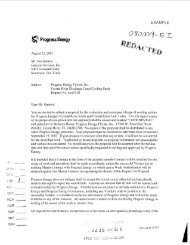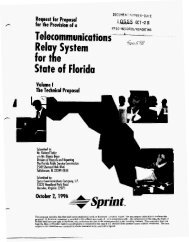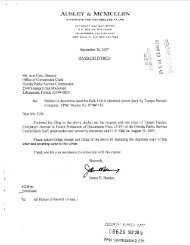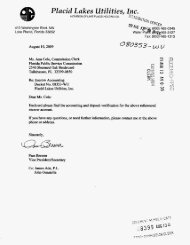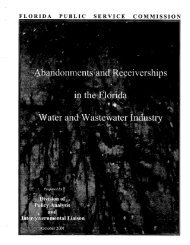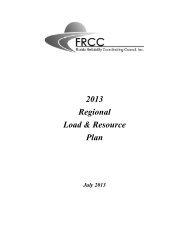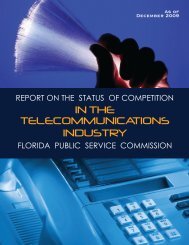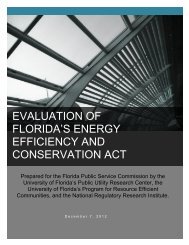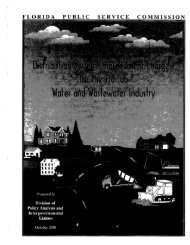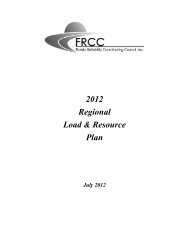Review of 2008 Ten-Year Site Plans - Public Service Commission
Review of 2008 Ten-Year Site Plans - Public Service Commission
Review of 2008 Ten-Year Site Plans - Public Service Commission
You also want an ePaper? Increase the reach of your titles
YUMPU automatically turns print PDFs into web optimized ePapers that Google loves.
Solar<br />
In order to demonstrate the feasibility and viability <strong>of</strong> clean energy systems, the Florida<br />
Legislature passed amendments to Section 366.92, F.S. The amendment allows full cost recovery<br />
under the environmental cost recovery clause for renewable energy projects that are zero greenhouse<br />
gas emitting at the point <strong>of</strong> generation up to a total <strong>of</strong> 110 MW. On July 15, <strong>2008</strong>, the <strong>Commission</strong><br />
approved FPL’s petition for the approval <strong>of</strong> eligibility for cost recovery <strong>of</strong> 3 solar energy projects<br />
totaling 110 MW.<br />
FPL’s largest proposed project, Martin Solar, will be a 75 MW solar thermal steam generating<br />
facility at the existing Martin Power Plant <strong>Site</strong> in Martin County, Florida. Martin Solar is designed to<br />
serve as a “fuel substitution” resource; thus, the facility is not designed to provide firm capacity.<br />
Martin Solar involves the installation <strong>of</strong> solar thermal technology integrated into the existing steam<br />
cycle for the currently operating Martin Power Plant Unit 8, a natural gas-fired combined cycle plant.<br />
The supplemental steam to be supplied by Martin Solar for the Unit 8 heat recovery steam generators<br />
will be generated from the concentration <strong>of</strong> solar radiation via parabolic trough solar collectors. Once<br />
constructed, Martin Solar will be the largest solar thermal facility in the world and the largest solar<br />
plant <strong>of</strong> any kind outside <strong>of</strong> California.<br />
Additionally, FPL is proposing the construction <strong>of</strong> two solar PV projects. DeSoto Solar and<br />
Space Coast Solar will generate 25 MW and 10 MW, respectively. DeSoto Solar will use a tracking<br />
array <strong>of</strong> solar PV panels, while Space Coast Solar will use fixed array solar PV panels. Both projects<br />
will convert energy from sunlight directly into electricity. FPL will consider both DeSoto Solar and<br />
Space Coast Solar as non-firm resources until sufficient operating experience is obtained to determine<br />
what contribution these facilities can reliably provide at FPL’s system’s peak hours.<br />
Utility Generation Efficiency and Modernization<br />
Current projections indicate that the state’s total energy demand will surpass existing DSM<br />
and energy efficiency programs <strong>of</strong>fered by Florida’s utilities and planned renewable generation.<br />
Therefore, the remaining generation needs must be met by traditional utility generation.<br />
The modernization <strong>of</strong> existing units also plays a key role in addressing several <strong>of</strong> Florida’s<br />
energy generation issues and concerns. The conversion <strong>of</strong> less efficient fossil steam generation to<br />
combined cycle generation increases capacity while reducing per unit emissions.<br />
In <strong>2008</strong>, the <strong>Commission</strong> granted FPL a need determination to convert four existing dual-fired<br />
steam generating units into two natural gas-fired combined cycle power plants with in-service dates in<br />
2013 and 2014, respectively. The approved conversions, located at FPL’s Cape Canaveral and<br />
Riviera sites, will transform more than 1,400 MW <strong>of</strong> relatively inefficient steam powered generation<br />
into approximately 2,400 MW <strong>of</strong> newer and more efficient combined cycle generation. FPL has<br />
estimated that the conversions will result in more than $450 million <strong>of</strong> net present value cost savings<br />
and will avoid approximately 8 million tons <strong>of</strong> CO2, illustrating the value and importance <strong>of</strong> such<br />
projects.<br />
<strong>Review</strong> <strong>of</strong> <strong>2008</strong> <strong>Ten</strong>-<strong>Year</strong> <strong>Site</strong> <strong>Plans</strong> - 20 -




